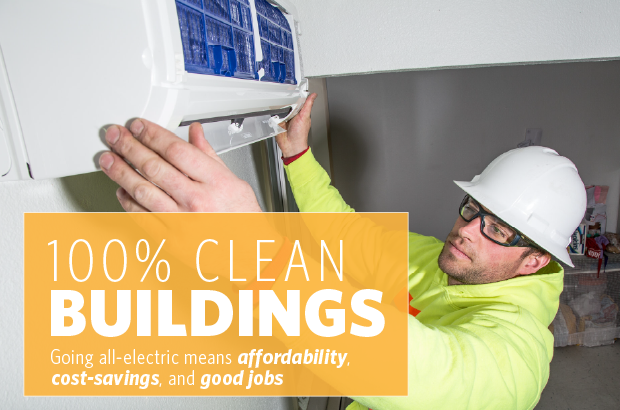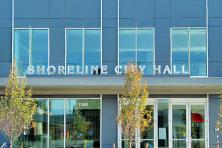Washington and Oregon have some of the lowest-cost electricity in the nation—ensuring homeowners and utility rate payers can access as much of that cheap, clean energy as possible to heat and power our buildings, while also promoting clean energy job growth, is another double-win from all-electric buildings.
The most cost-effective way to achieve our GHG goals
Washington is committed by law to reducing greenhouse gas emissions by 95% below 1990 levels by the year 2050; Oregon Governor Kate Brown issued an executive order in 2020 that directed Oregon agencies to reduce emissions by at least 80% below 1990 levels by 2050. Washington State’s Deep Decarbonization Pathways study showed that the lowest-cost pathway for achieving the state’s climate goals by 2050 relies on electrifying our buildings. If we continue to heat our homes with gas, that transition will be much costlier.
That’s good news for us! Homeowners, tenants, and builders will see cost-savings from new all-electric homes, both upfront and over a 15-year time period. As we shift to all-electric buildings statewide, our easiest lift is to make sure all our new buildings use highly efficient electric heat pumps and other electric appliances. Many homeowners are already making the switch, but we will need to ensure our state’s policies help low-income families who can’t afford the upfront costs of transitioning off of gas.
All-electric homes save money in the long and short term
We need to start electrifying as soon as possible to minimize the risks from climate change, but also to increase access to affordable, clean energy sources. As more customers move off of gas, the cost of electricity will decrease for everyone on the grid, and customers will benefit from more stable energy prices as utilities reduce dependence on volatile fossil fuels and transition to clean electricity. In Washington, utilities are also required to provide financial assistance for low-income customers to pay their electric bills. There are no such protections for gas customers. In 2019, Washingtonians spent an extra $67 million building homes with gas unnecessarily. Washington and Oregon can’t afford to keep digging the hole deeper, especially for affordable housing that will protect low-income customers from being the last stuck on gas lines.
On the other hand, if we do not immediately begin to transition off gas, buildings constructed now with gas will need to be retrofitted later to move to electricity, at even greater cost. And because low-income residents will be the last to go through expensive conversions, they will also bear the burden of rising gas prices. Since new buildings often have a life expectancy of over 50+ years, and pipeline systems have similarly long lifespans, any new gas infrastructure installed now will turn into stranded assets in the future.
So what about the cost of building all-electric?
All-electric homes are cheaper to build upfront and don’t have to incur the cost of a new connection to gas pipeline infrastructure. All-electric home appliances are readily available, increasingly cutting-edge, and many utilities have rebates available for highly efficient models. Plus all-electric heating adds to our climate resilience. In Western Washington, approximately 50-75% of new town homes and single-family housing already have air conditioning included; in an all-electric home, highly efficient heat pumps save money because they serve as both a heat source and an air conditioner. Climate change is causing sustained hotter temperatures in Washington and Oregon, and we expect to see a substantial increase in air conditioning in new homes. A recent report from the Rocky Mountain Institute (Economics of Electrifying Buildings report), as well as several other studies, found that in Seattle, an all-electric home saves $4,300 in lifecycle costs and 28 tons of CO2 emissions over a 15-year period.
Creating new green jobs
Shifting to all-electric buildings will also create jobs in the Pacific Northwest in many sectors. By developing and growing our green workforce and reducing our reliance on gas rather than continuing to buy dirty fuels from out-of-state our economy will experience benefits from electrification.
All-electric building technology—including heat pumps and induction cooking appliances—are already in use in homes and buildings across Washington and Oregon. These technologies are not new, and will only continue to become more affordable, but we’ll need to increase and train the workforce needed to grow our all-electric building stock. A UCLA study on workforce development needs and impacts for a full-transition to electric buildings in California found that the net impact was an overwhelming increase in job creation—estimating an excess of 100,000 new annual positions. Washington and Oregon would be expected to see similar rates of net job creation, scaled to our states’ sizes and current gas usage.
The switch to all-electric buildings will require a just transition that provides resources for fossil fuel workers while still moving us towards a carbon-free future. Because Washington and Oregon both get natural gas shipped in from Canada and the Rocky Mountain states, electrification will not lead to significant gas extraction job losses in our states. Instead, we’ll have opportunities to create new positions in sectors including equipment manufacturing, renewable energy construction, electricity generation and distribution, and building electrification. We’ll need to ensure that these jobs in construction and retrofitting stay local to benefit Washington residents.
Electrifying our buildings offers us the exciting opportunity to reduce costs for builders and ratepayers, as well as creating the workforce that will power our green economy. In our final piece of this series, we’ll talk about some of the policy mechanisms for making this transition happen, and how you can be involved!





